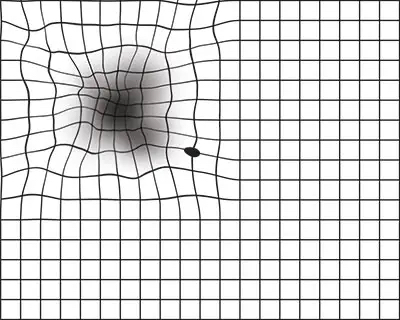Wet age-related macular degeneration (AMD) affects around 10% of individuals who have macular degeneration. Wet AMD is more likely to cause a relatively sudden change in vision; resulting in serious vision loss.
During this type of macular degeneration, abnormal blood vessels develop inside of the retina and leak fluid and blood into layers of the macula. This can cause scar tissue to form and retinal cells to stop functioning – which can lead to permanent scarring and may distort your vision.
Wet macular degeneration symptoms usually appear suddenly and worsen rapidly. Individuals with wet AMD may experience all dry AMD symptoms, as well as:
- Dark “spots” in their central vision
- Straight lines appearing wavy

Source: American Academy of Ophthalmology
Wet AMD Treatment
The most common, and effective, treatment for wet age-related macular degeneration is called anti-VEGF therapy. In this treatment, a doctor injects medication directly into the eye.
The thought of having an injection into the eye can be intimidating, so let’s discuss what to expect when the medication is administered and what you may experience afterwards.
Anti – VEGF Injection
Injections for wet macular degeneration can help to stabilize or even improve vision in some cases.
Wet AMD is caused by the growth of extra blood vessels leaking due to an overabundance of VEGF. VEGF stands for vascular endothelial growth factor. It’s a protein that helps the growth of blood vessels when your body needs them. Anti-VEGF medication blocks this growth factor and is injected directly into the eye in order to reduce the blood vessel growth. Anti-VEGF therapy ultimately helps to curb fluid leakage in the retina.
There are currently four types of anti-VEGF injections used to treat wet AMD:
- Aflibercept (Eylea)
- Bevacizumab (Avastin)
- Brolucizumab (Beovu)
- Ranibizumab (Lucentis)
What to Expect During Treatment
To begin the treatment, a doctor will first numb the eye with eye drops. The needle used to inject the treatment into the eye is very small and thin and is administered in less than a second. In order to properly inject the anti-VEGF, the needle will go as far back as the vitreous part of the eye (the jelly-like substance in the middle of the eye).
The injection should be relatively painless. Some people experience slight discomfort, pressure or see wavy lines. However, these symptoms usually will not last long.
What to Expect Post Treatment
After the treatment, the eye may be sore and the vision slightly foggy for a day or two. However, these symptoms are typically mild and will go away in a few days.
The recommended frequency of anti-VEGF injections may vary from every few weeks to every few months. To experience the best results, patients will likely require multiple doses for continued benefit.
Anti-VEGF treatments are highly successful in helping patients retain their vision and preventing wet AMD vision loss. In fact, up to 90% of people experience vision stabilization with anti-VEGF treatments.
The Takeaway
Wet AMD that remains untreated is one of the leading causes for age-related blindness. It is important to have routine eye exams in order to catch wet AMD early enough to prevent vision loss. If you are interested in finding out more about wet AMD treatments, please reach out today to schedule an appointment. Dr. Pandya services the Dallas Fort Worth community with offices in both Plano and Waxahachie, Texas.

